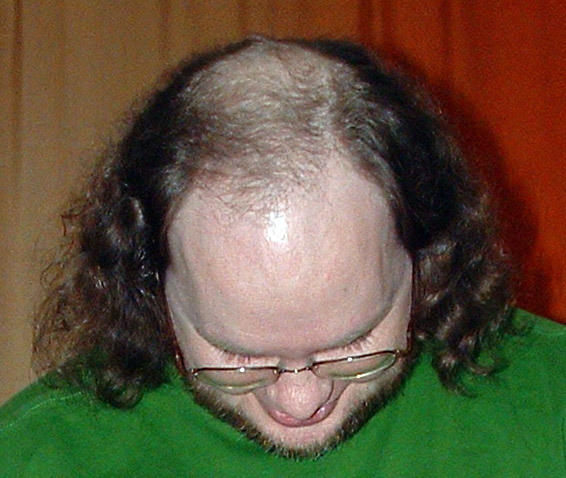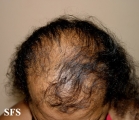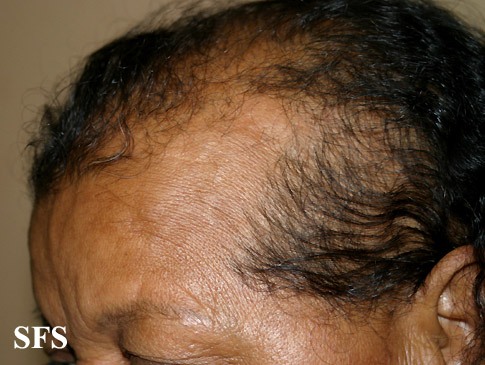Androgenic alopecia
| Androgenic alopecia | |
 | |
|---|---|
| Male pattern baldness in a 40 year old man. | |
| ICD-10 | L64 |
| DiseasesDB | 7773 |
| eMedicine | derm/21 |
Editor-In-Chief: C. Michael Gibson, M.S., M.D. [1]; Associate Editor(s)-in-Chief: Jesus Rosario Hernandez, M.D. [2]
Synonyms and keywords:: Androgenetic alopecia, alopecia androgenetica.
Androgenic alopecia (also known as androgenetic alopecia or alopecia androgenetica) is a common form of hair loss in both men and women. In men, this condition is also known as male-pattern baldness. Hair is lost in a well-defined pattern, beginning above both temples. Over time, the hairline recedes to form a characteristic "M" shape. Hair also thins at the crown of the head, often progressing to partial or complete baldness.
The pattern of hair loss in women differs from male-pattern baldness. In women, the hair becomes thinner all over the head, and the hairline does not recede. Androgenetic alopecia in women rarely leads to total baldness.
A variety of genetic and environmental factors likely play a role in causing androgenetic alopecia. Although researchers are studying risk factors that may contribute to this condition, most of these factors remain unknown. Researchers have determined that this form of hair loss is related to hormones called androgens, particularly an androgen called dihydrotestosterone (DHT). Androgens are important for normal male sexual development before birth and during puberty. Androgens also have other important functions in both males and females, such as regulating hair growth and sex drive.
Hair loss and genetics
Researchers suspect that several genes inherited from both parents play a role in androgenetic alopecia. Paternal hair loss has been shown to correlate with chances of alopecia in sons, while variations in the androgen receptor gene (AR), which can also correlate with baldness, are X linked and thus inherited from one's maternal grandfather or grandmother.
Androgen receptors allow the body to respond appropriately to dihydrotestosterone and other androgens. Studies suggest that variations in the AR gene lead to increased activity of androgen receptors in hair follicles. It remains unclear, however, how these genetic changes increase the incidence of patterned hair loss in men and women with androgenetic alopecia.
The inheritance pattern of androgenetic alopecia is unclear because many genetic and environmental factors are likely to be involved. This condition tends to cluster in families, however, and having a close relative with patterned hair loss appears to be a risk factor for developing the condition.
Men with androgenic alopecia typically have lower levels of total testosterone, higher levels of unbound/free testosterone, and higher levels of total free androgens including DHT.[1][2]
5-alpha-reductase is responsible for converting free testosterone into DHT. The genes for 5alpha-reductase are known[3]. The enzymes are present predominantly in the scalp and prostate. Levels of 5alpha-reductase are one factor in determining levels of DHT in the scalp and drugs which interfere with 5alpha-reductase (such as finasteride, which inhibits the predominant type 2 isoform ) have been approved by the FDA as treatments for hair loss.
Sex hormone binding globulin (SHBG), which is responsible for binding testosterone and preventing its bioavailability and conversion to DHT, is typically lower in individuals with high DHT. SHBG is downregulated by insulin.
Increased levels of Insulin Growth Factor-1 (IGF-1) have been correlated to vertex balding [4]
High insulin levels seem the likely link between metabolic syndrome and baldness. Low levels of SHBG in men and non-pregnant women are also correlated with glucose intolerance and diabetes risk, though this correlation disappears during pregnancy. [5]
Hair loss and lifestyle
While genetic factors play a strong role in the development and progression of androgenetic alopecia, lifestyle also plays a role as demonstrated by the vast increase in male pattern baldness in Japan after World War II.
Daily, vigorous aerobic exercise (as opposed to short workout periods designed to raise androgen levels and build muscle or more sporadic exercise) has been shown to reduce baseline insulin levels as well as baseline total and free testosterone, significantly lowering baseline DHT.[6] It has been suggested that weight training may have a detrimental effect on hair by increasing testosterone levels; however, there is at least one study that indicates a decline in free testosterone as result of weight training.[7]
Physical examination
Gallery
Head
Treatments
While many people with male pattern baldness choose to accept the condition, there are baldness treatments which can reduce or halt hair loss, and in early stages or rare cases, reverse it entirely. Treatments from most to least effective include:
- Hair transplantation
- Dutasteride
- Finasteride
- Minoxidil
- Ketoconazole
- Saw Palmetto Extract
- Topical Caffeine [8]
References
- ↑ http://www.ncbi.nlm.nih.gov/entrez/query.fcgi?cmd=Retrieve&db=pubmed&dopt=Abstract&list_uids=14758568&query_hl=18
- ↑ http://www.ncbi.nlm.nih.gov/entrez/query.fcgi?cmd=Retrieve&db=pubmed&dopt=Abstract&list_uids=9349747&query_hl=4&itool=pubmed_docsum
- ↑ http://www.ncbi.nlm.nih.gov/entrez/query.fcgi?cmd=Retrieve&db=pubmed&dopt=Abstract&list_uids=16155734&query_hl=36&itool=pubmed_docsum
- ↑ http://www.ncbi.nlm.nih.gov/entrez/query.fcgi?cmd=Retrieve&db=pubmed&dopt=Abstract&list_uids=10025745&query_hl=1&itool=pubmed_docsum
- ↑ http://www.ncbi.nlm.nih.gov/entrez/query.fcgi?cmd=Retrieve&db=pubmed&dopt=Abstract&list_uids=16492215&query_hl=19&itool=pubmed_DocSum
- ↑ http://www.ncbi.nlm.nih.gov/entrez/query.fcgi?cmd=Retrieve&db=pubmed&dopt=Abstract&list_uids=15618989&query_hl=16&itool=pubmed_docsum
- ↑ Ara, I.; Perez-Gomez, J.; Vicente-Rodriguez, G.; Chavarren, J.; Dorado, C.; Calbet, J. A. L. (2006). "Serum free testosterone, leptin and soluble leptin receptor changes in a 6-week strength-training programme". British Journal of Nutrition. 96 (6): 1053–9.
- ↑ Fischer TW; et al. (2007). "Effect of caffeine and testosterone on the proliferation of human hair follicles in vitro". Int J Dermatol. 46(1): 27&ndash, 35.
Bibliography
External links
- International Society of Hair Restoration Surgery Resources for finding doctors, and more information about hair loss. This is one of the leading organizations in the world on hair loss.
- Medical Treatments for Balding Men: April 1999, American Family Physician (medical journal)
- Commercial treatment reviews Examines hair loss products, and the claims made by their manufacturers.
- How Hair Replacement Works Covers oral medications, hair transplant surgery, and topical treatments.
- Alopecia UK

